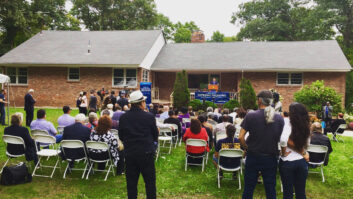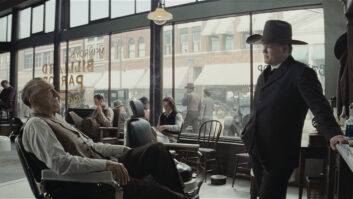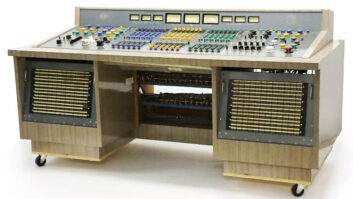Debuting more than a half-century ago, Oklahoma! represented a number of firsts. This big-budgeted film retelling of the Rodgers & Hammerstein Broadway hit mixed lively dance numbers with a dark, brooding performance by villain Rod Steiger. Released in 70mm Todd-AO with a 6-track (L/Lc/C/Rc/R/mono surround) mag score, the film was simultaneously shot in two different formats — 65 mm and 35mm Cinemascope — to simplify the creation of road show and general theater versions.
To help bring this 1955 classic back for a special DVD package (including complete versions of the Todd-AO and Cinemascope releases), 20th Century Fox turned to Chace Productions, a Burbank, Calif. — based audio post company specializing in audio restoration/remastering for film and broadcast. Chace had previously done projects such as The Wizard of Oz and Gone With the Wind, but was anxious to try something different on Oklahoma!.
Last year, Chace became the exclusive provider of Plangent Processes’ Clarity Audio Restoration system for the film/video industries. Using a proprietary wavelet-based resampling algorithm first developed by Dr. Patrick J. Wolfe at Cambridge University, this hardware/UNIX software system can remove wow and flutter from analog recordings. “We looked at the mechanical anomalies of tape machines to see if it was possible to nullify some of those analog flaws,” says Plangent Processes founder Jamie Howarth. In the simplest terms, the process can correct speed and pitch variations inherent in a tape recording by synching to the tape’s own bias frequency. “The answer was using DSP to model problems — such as a rumbling transport bearing or flutter from an out-of-round capstan — and applying a self-cancelling error to knock some of those out,” explains Howarth.
While pops, clicks, hiss and transient noise removal have been addressed by current products, “wow has always been the unsolvable problem,” notes Chace president Bob Heiber. “It really exhibits itself in telephone rings, long sustained notes and music. Until now, it’s not been correctable except by finding an alternative source that’s not flawed.” When Heiber first heard about Howarth’s process, he was impressed: “Finally, there was somebody solving audio problems that we used to tell customers they had to live with.”
As the first feature film restoration where Chace used the Clarity system, Oklahoma! was a complex project, especially in restoring both Todd-AO and Cinemascope versions. “It might have been tempting to use the higher-quality 6-track materials to replace the badly deteriorated 4-track masters from the Cinemascope release,” says Heiber. “We didn’t try to integrate the 6-track audio into the 4-track versions of the musical numbers. It’s a credit to Schawn Belston, VP of asset management at 20th Century Fox, who really wanted to keep the organic feel of both films and not try to ‘improve’ or alter the original performances.”
Jamie Howarth of Plangent Processes
Luck was on their side. “Fortunately, we transferred those 4-track materials to 2-inch 24-track back in 1992 when we were working on an earlier preservation project,” says Heiber. On the other hand, “The 35mm six-stripe mag masters were in surprisingly good condition for their age and didn’t require any heroic measures in terms of the transfers.”
Yet even with clean, playable masters, the amount of wow and flutter in the original recordings was problematic. “The original 6-track sounded okay, but due to deterioration, there’s a serious amount of wow in it and a pervasive 96Hz [24 frame × four perfs/frame] sprocket flutter that exists on everything that comes off a mag machine,” explains Howarth, who worked closely with Chace on the project. “Normally, when you listen to flutter at a low rate, it’s a gargle sound, but when you get up that fast, it actually becomes intermodular distortion and creates a signature harshness, which is the sound of 1950s films. Once we knocked that out, the film didn’t sound like an antique anymore. Fox was happy with the results.”
Having access to the original 6-track mag master (rather than working from a release print) was another plus for the Chace team. “We were able to bring the mix one generation back,” says Heiber. “The orchestral music is absolutely glorious — it pins you to the back wall.”
At press time, Chace was working on an upcoming release of another Rodgers & Hammerstein film musical: the 1958 South Pacific. On this project, the wow problems were far more serious than those on Oklahoma!. “In one section of the main title vocal on ‘Bali Ha’i,’ there were some major dips — a perfect fifth — that were horrible,” says Howarth. “We were able to completely straighten that out and stabilize the pitch to the point where its wow and flutter compares to a digital recording. This DVD will be the first time the film’s musical performances have ever been heard correctly.”
Using the Clarity process brought other factors to light. “This whole issue of machine instability, amplitude modulation and the FM flutter characteristic brought me to rethink the entire process of analog recording,” says Heiber. “We used to blame the electronics and the tape medium, but machine instability is the weak link in recording. No matter how well designed, every analog transport has a wow and flutter spec. The Clarity process removes two layers of the instability in the audio, from both the original recorder and the playback machine.
“The result is a clearer, purer sound that’s really evident in reverberation tails, high-frequency trail-off and less overall tubbiness,” he continues. “Jamie calls it removing the ‘interstitial haze,’ so it’s like lifting a light gauze that masks the subtleties of the soundtrack.”







